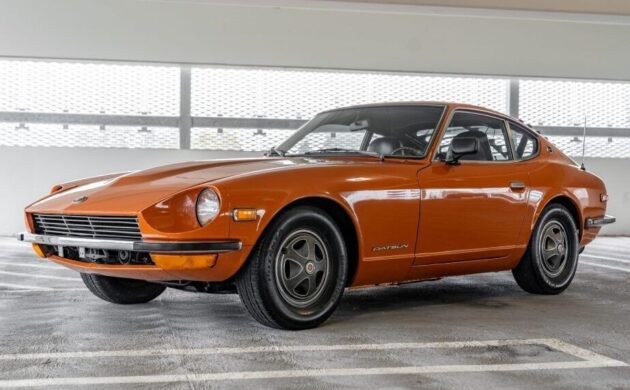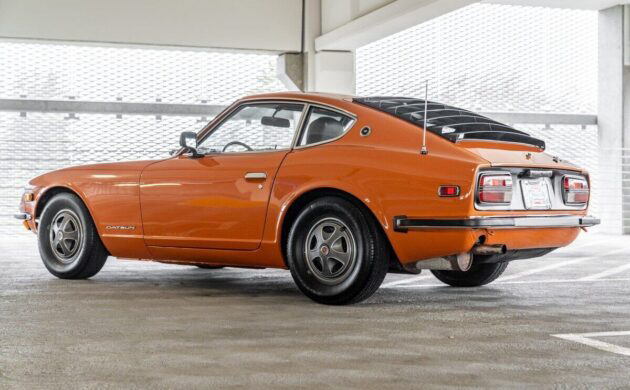The Japanese motor industry was one of the fastest evolving during the second half of the twentieth century. The early post-war years saw it producing slower and heavier copies of cars designed by European manufacturers, but by the 1960s, its products exhibited fit and finish levels to rival anything built across the globe. Datsun’s reputation was grounded in cheap offerings, but it demonstrated its potential with the release of the 240Z. Our feature car is a 1972 model that is a one-owner classic. It presents beautifully following a recent restoration, with the seller listing it here on eBay in San Jose, California. Bidding has raced to $18,200, although that remains short of the reserve.
The 240Z was not the first two-seat sports coupe from a Japanese manufacturer. The most notable car of a similar size and style was the Toyota 2000GT, which beat it to the market by two years. However, the high sticker price of the Toyota meant that only 351 buyers could be found. Datsun followed a more conservative route with the 240Z, and although it wasn’t as mechanically sophisticated as the 2000GT, it was significantly more affordable. By the time production ended in 1973, the company’s records confirm that a staggering 168,584 examples were plying the world’s roads. Our feature car emerged from the factory in 1972 and is a one-owner classic. It was ordered in New Sight Orange, a shade available throughout the 240Z production cycle. It recently received a bare metal restoration, although the seller emphasizes the goal wasn’t to create a trailer queen. They aimed for a high-end driver, and it appears they hit the mark. The paint shines beautifully, and the panels are as straight as an arrow. There is no evidence of rust, and given the car’s history of living in a dry climate, that is unsurprising. The trim and glass are spotless, and the car rolls on its original wheels that wear the correct hubcaps.
Many people compare the styling of the 240Z with the Jaguar E-Type, which is understandable. Those similarities continue below the skin, with both cars featuring a straight-six engine that sends its power to an independent rear end via a four-speed manual transmission. However, that is where the comparison ends. The Datsun’s 2.4-liter powerplant receives a single overhead camshaft, although the standard dual-row timing chain and double valve springs make these robust motors that will rev freely beyond 6,000rpm. The driver will have 151hp and 146 ft/lbs of torque at their disposal. That is enough to launch the car through the ¼-mile in 16.6 seconds and on to a top speed of 125mph. The 240Z might not have been as fast as a ’72 E-Type, but with a sticker price of around 50% of the British thoroughbred, the shortcoming was forgivable. The seller provides no information on how this classic runs or drives, but the visual indications are positive. The ownership history is also encouraging, suggesting the Datsun has spent its life as a cherished family member.
When I first saw the location of this 240Z, I was bracing for an interior showing deterioration and UV damage. The dash and pad are particularly prone areas, but there is nothing inside this car deserving criticism. The Black vinyl upholstered surfaces are spotless, as is the carpet. There is no cracked or crumbling plastic, and it is refreshing to find no aftermarket additions. The car retains its correct steering wheel, shifter knob, and AM/FM radio. I’m not sure if I can use the term “as-new” to describe the condition, but it certainly won’t cause the new owner any shame when they appear in public behind the wheel of this classic.
It is often said that history never repeats, but I don’t believe that is strictly true. Early Japanese cars were generally pretty awful. However, the Datsun 240Z graphically demonstrated how far the country had come in producing world-class vehicles in little more than two decades. The same appears to be the emerging trend from South Korea. It wasn’t many years ago that offerings from Kia and Hyundai exhibited poor quality, and people bought those cars because they were extremely cheap. Huge strides have been made in the last twenty years, with models like the Kia Stinger offering staggering performance and excellent build quality. Could the Stinger become a future classic? Only time will reveal the truth. The 1972 Datsun 240Z is already a classic, and recent sales results confirm that. An enthusiast could roll the dice, hoping for the best from the Stinger. Me? I’d sink my money into this 240Z and drive away in a sure thing. What about you?






Such potential—then after all that—the orange was paint applied —and painted a few shade’s off. Bummer—can’t be changed. So much work—all in the hand’s of a painter ordering paint from a paint company mixed by someone in a hurry. Wow.
I would defer to you as an aficionado, but I’m not so sure the color is off. All the shots are in a dark-ish garage on what appears to be a cloudy day. The orange definitely looks dark in many of the pics, but it looks much more vibrant in the few taken in brighter light. Regardless, I think the owner has produced a very pretty Z. Love those stock wheel covers.
The problem with anyone making appraisal about the color is that each person is viewing with a mainly uncalibrated viewing monitor. So, the range of hues in this color can vary greatly.
The color looks pretty spot on to me. Even considering how color varies across devices.
The color looks right to me. What I notice is the shine of a clearcoat. So much more reflective than the old paint. I’m not sure the depth of the paint isn’t what makes the color seem darker, but regardless, it sure is beautiful. And no fender rust behind the front wheels! Speaking from experience, these are sure nice cars to drive and I’m sure this one won’t disappoint.
The Stinger is the only new car that I’d consider buying. It’s got great looks and performance, similar to the way the 240Z presented in it’s time. If I had to choose one new car from today’s offerings, and one car only, for the rest of my life, it’d be the Stinger.
I know this dealer. He has all interesting cars we all love. I personally think his prices are high but that is a dealer for you. Buy low sell high.
I don’t see the orange being off either, very slight if it is.
I looked at this cars twin probably 30 years ago owned by a male teacher in San Jose no less. I cannot remember price but I passed because it was dinged like an sob up and down the sides.
I had a 1973 240Z that looked exactly like that when I bought it in 1975 including the hub caps and rear window louvers. I bought it from a Mercury dealer in San Jose. Had a lot of fun in that car and a few tickets one racing Camaro on the freeway in Livermore doing 115. The CHP said I was winning.
I know of a one owner 240Z that has been in a garage since a good friend of mine passed away in his early 80s. The purchased the car new and had dealer installed A/C added. I’ve driven the car in the passed and wish I could buy it. It looks almost identical to the one in this article.
His family needs to sell his also.
The valve cover says nissan instead of datsun. no mention what was done to the engine.
I had a 71 240 Z was the lemon yellow it had one repaint and color was a little off but was ok with me. It was owned by a middle age woman and was fairly stock other then some real wire wheels. I had looked at a few that had been owned by young punks on dope no thanks ! Did find the gal that owned mine had not kept up with services but was still better then beat by some hooligan.
Bid to $19,700.00 but reserve not met. Nice looking Z. Would need some closeup pics of the usual rust areas.
Nissan was stamped on most of the internal parts. At least in my ’78 280Z. Even the small white writing on my windows that said “Nissan.” Datsun was only used in the US, and right before the Datsun name went away, it became “Datsun by Nissan.”
Yes towards the end of the 70’s the internals were stamped nissan. I had a 1979 datsun 210 which was stamped nissan.But I know people who had early 70’s datsuns and the internals were stamped datsun. Which made me ask did he do engine work.
Interesing. Datsun was always made by Nissan, and I’ve never seen a Datsun engine not stamped “Nissan.” Even my old Datsun 310GX that I had when I was a kid in highschool said Nissan on it. Datsun only existed in the USA, and as far as I know and can remember, the only things stamped with “Datsun” were the external nameplates and the interior of the car. Even the little tiny lables on the windows had “Nissan” on them.